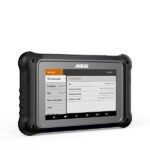The 7.3 Powerstroke diesel engine, renowned for its durability and power, can benefit significantly from monitoring with an OBD2 scanner. Understanding transmission temperatures is crucial for the longevity of these trucks, and early models, in particular, had issues with overheating. Ford’s solution involved incorporating an “Over-the-Water” (OTW) transmission cooler integrated into the radiator, supplementing the existing “Over-the-Air” (OTA) cooler. This upgrade, prompted by high warranty claims for transmission failures due to overheating, proved effective in reducing transmission fluid temperatures. Ford even issued a Technical Service Bulletin (TSB) allowing owners of earlier models to have the OTW cooler retrofitted under warranty.
Understanding the 7.3 Powerstroke Cooling System
While the factory OTW cooler upgrade significantly improved cooling performance, many 7.3 Powerstroke owners still opt for aftermarket OTA coolers for added protection. Popular options, like the 6.0L cooler or Mishimoto performance coolers, are easier to install than a complete radiator replacement with integrated OTW cooling. This preference stems from the less invasive installation process of OTA coolers. Furthermore, even trucks equipped with the OTW cooler often receive an aftermarket OTA cooler upgrade as an extra precaution against overheating, especially for towing or heavy-duty use.
The primary concern with adding a third cooler to the system is potential flow restriction and decreased overall cooling efficiency. As these trucks age, the factory radiators can become less efficient due to internal corrosion and debris buildup. Replacing the original radiator with one featuring an integrated OTW cooler is a recommended preventative maintenance step for older 7.3 Powerstrokes. This not only addresses potential cooling issues but also ensures the longevity of the transmission.
Personal Experience with 7.3 Powerstroke Cooling Upgrades
Even without the factory OTW cooler, upgrading to a Mishimoto OTA cooler has proven effective in maintaining optimal transmission temperatures. However, it’s worth noting that installing a larger OTA cooler might slightly increase Exhaust Gas Temperatures (EGTs). This potential rise in EGTs is likely attributable to the cooler obstructing airflow through the Charge Air Cooler (CAC). While the increase is generally minimal, it’s a factor to consider. Conversely, the improved cooling capacity of the transmission cooler could also introduce slightly warmer air into the intake tract, contributing marginally to the EGT increase.
Conclusion: Using your 7.3 Powerstroke OBD2 Monitor for Transmission Temperature
Monitoring transmission fluid temperature with a 7.3 Powerstroke Obd2 Monitor, especially after adding an aftermarket cooler, is essential. Ensuring your 7.3 Powerstroke’s cooling system is up to par is crucial for its longevity and performance. Whether you choose to retrofit the factory OTW cooler, install an aftermarket OTA cooler, or both, diligent monitoring and maintenance will ensure your 7.3 Powerstroke continues to deliver reliable power for years to come. Regularly inspecting your coolant levels and considering a radiator replacement as your truck ages are proactive steps to prevent overheating and costly repairs down the road.

